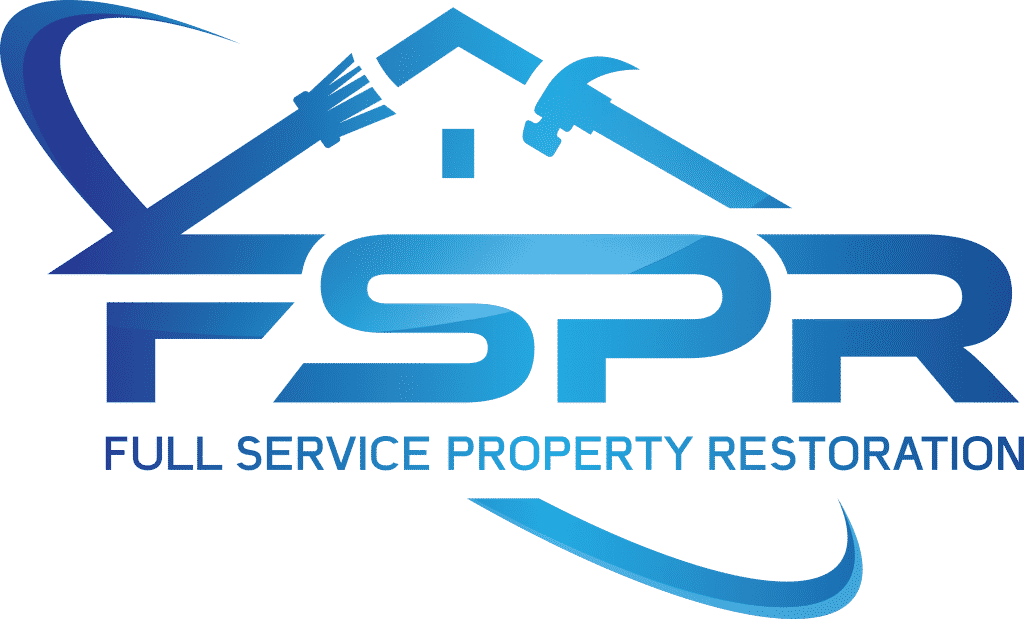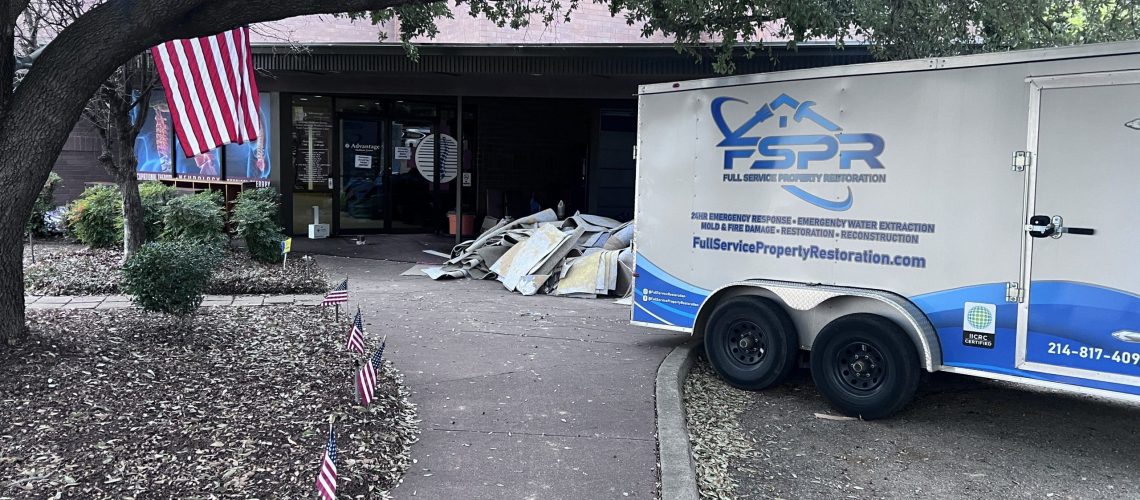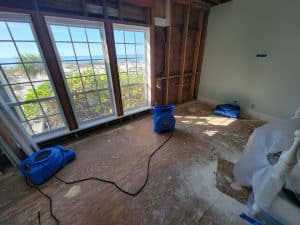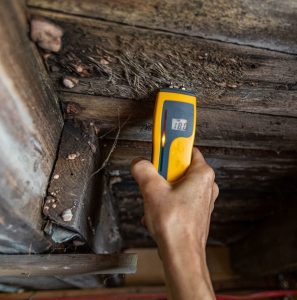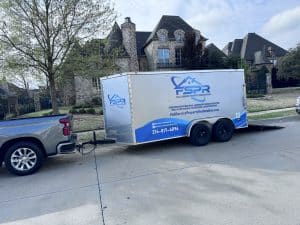When water damage shows up in your home or business, it can be tough to know just how serious it is. Is it something you can dry out with a fan and move on? Or is it hiding deeper damage that could cause major problems later?
At Full Service Property Restoration, we’ve seen it all—from small leaks behind a dishwasher to full-blown floods thatij drywall, flooring, and personal belongings. Here’s what we can tell you: even small signs of water damage can turn into big issues if they’re ignored. So how can you tell when water damage is serious and when it’s just a surface-level inconvenience?
Let’s break it down.
Key Takeaways
- Small signs of water damage (like stains or warping) can indicate deeper issues
- Mold growth, musty odors, and buckling materials are red flags of serious water damage
- Water type (clean, gray, or black) affects the urgency and risk level
- Time makes the damage worse, so a quick response is essential.
- A professional inspection is the only way to know for sure how serious the damage is
Visible Water Damage vs. Hidden Water Damage
Some water damage is easy to spot: warped floors, stains on ceilings, bubbling paint, or puddles under appliances. Other times, though, water seeps into the structure of your home, like behind walls, under floors, or into insulation,without leaving obvious signs.
Visible water damage is often the tip of the iceberg. If you can see water spots, discoloration, or swelling in materials like drywall or wood, there’s a good chance more is going on beneath the surface. If the source of the water hasn’t been stopped completely, the damage can keep spreading.
Hidden water damage tends to be more dangerous because it can go unnoticed for days or even weeks. By the time it becomes visible, mold growth or structural deterioration may have already started.
Bottom line? If you’re seeing visible signs of water damage, there’s a real chance there’s more you’re not seeing.
Signs That Water Damage Is Serious
Here are the red flags we look for when determining the severity of water damage:
1. Musty Odors
A persistent musty or earthy smell is often a sign of hidden water damage, and possibly mold. This smell typically comes from moisture trapped behind walls, under flooring, or in insulation. If the odor doesn’t go away after cleaning or ventilating the area, it’s time to call a professional.
2. Mold Growth
Mold starts growing within 24 to 48 hours of a water incident. If you see fuzzy patches, black spots, or even white powdery growth, that means moisture is still present. Mold is a serious health risk and a clear sign the water damage has gone deeper than the surface.
3. Warping, Buckling, or Sagging
When materials like wood, laminate, or drywall absorb too much moisture, they start to deform. You might notice your hardwood floors are cupping, your walls are bulging, or your ceiling is sagging. These are major indicators that the structural integrity of your home is at risk.
4. Peeling Paint or Wallpaper
If you notice paint bubbling or wallpaper starting to peel, that’s often a sign that water is trapped underneath. While it may not look major at first, this usually points to a leak that’s been happening over time.
5. Stained or Discolored Surfaces
Dark or yellowish stains on your ceiling, walls, or flooring mean moisture has been there long enough to soak through. Even small stains can point to a larger problem, especially if the spot grows or reappears after cleaning.
6. Rust on Metal Fixtures
If you see rust on nails, pipes, or HVAC components, there’s likely ongoing moisture in the area. Rust usually forms with consistent water exposure, not just a one-time event.
7. High Humidity or Condensation
If a room always feels humid or you see frequent condensation on windows or walls, it could mean water is evaporating from a hidden source. That continued moisture can feed mold growth and cause further damage over time.
Depending on the Type Of Water, Its Impact Can Vary
Not all water is equal when it comes to damage. The type of water involved in a leak or flood plays a huge role in how serious the situation is.
Clean Water (Category 1)
This is water from a clean source like a broken pipe or rainwater. If it’s cleaned up quickly, damage is usually minimal. But if it sits too long, it can still lead to mold growth and material breakdown.
Gray Water (Category 2)
Gray water is slightly contaminated, like water from a washing machine, sink, or dishwasher. It can cause illness with prolonged exposure and will cause damage more quickly than clean water.
Black Water (Category 3)
Black water is highly contaminated, often from sewage backups, floodwater, or toilet overflows. This type of water poses serious health risks and causes severe damage that requires professional cleanup.
If your water damage involves gray or black water, it’s serious and needs to be handled by a professional, no matter how small it looks.
Time Is a Big Factor
The longer water damage sits, the worse it gets. Even clean water can become contaminated and destructive in just a few days.
Here’s a general timeline:
- Within hours: Water begins soaking into walls, flooring, and furniture. Paint may bubble, and materials start to weaken.
- Within 24–48 hours: Mold begins growing. Wood swells. Metal rusts. Odors may begin.
- Within a week: Structural damage sets in. Mold colonies spread. Indoor air quality declines.
- After a week: Major repairs are often needed. Demolition may be required. Insurance claims can become more complicated.
If you’re dealing with water damage, don’t wait to get help. Timing can make a world of difference between simple drying and major reconstruction.
What Happens if You Ignore It?
Here’s what can happen if water damage is left untreated:
- Mold and mildew: These can spread quickly and cause health issues like allergies, asthma, or respiratory infections.
- Structural deterioration: Wood rot, corrosion, and weakening of drywall or framing can put your property at risk.
- Electrical hazards: Water near wiring can cause shorts, shocks, or even fires.
- Pest infestations: Damp wood and drywall attract insects like termites and cockroaches.
- Decreased property value: Visible and hidden damage can scare off buyers and lower resale value.
What looks like “just a little water” can spiral into thousands of dollars in repairs if it is not addressed right away.
Professional Inspection Is Key
Even if the damage looks small, it’s hard to know what’s really going on without the right tools. At Full Service Property Restoration, we use moisture meters, infrared cameras, and other detection equipment to find hidden water and assess the full extent of the damage.
Our job is to figure out what’s been affected, how deeply the water has penetrated, and what steps are necessary to fix it for good.
When to Call a Professional
You should reach out to a restoration professional if:
- You notice any of the signs listed above (mold, odors, warping, etc.)
- The water has come from a contaminated source (like sewage or floodwater)
- The damage covers a large area or multiple rooms
- You’ve had recurring leaks in the same spot
- You want peace of mind that your home is safe and fully dried
We’re here to help you avoid bigger problems and restore your property quickly and safely.
What We Do at Full Service Property Restoration
We’re not just here to dry things out. Our team handles everything from the initial inspection to full cleanup, repairs, and restoration. That includes:
- Emergency water extraction and drying
- Moisture detection and damage assessment
- Mold prevention and mitigation
- Structural drying and dehumidification
- Cleanup and repairs to walls, flooring, and more
We work with homeowners, business owners, and insurance companies to make sure everything is done right and nothing is overlooked.
Final Thoughts
Water damage is one of those problems that just doesn’t get better on its own. Whether it’s a slow leak behind a wall or a sudden pipe burst, the longer you wait, the more you risk expensive repairs, mold issues, and even structural danger.
If you’re unsure whether the water damage in your home or building is serious, err on the side of caution and give us a call. At Full Service Property Restoration, we’re here to assess the damage, find hidden moisture, and restore your property with care, speed, and expertise.
Let us help you get back to normal, safely and completely. Call us today for an immediate response to your water damage scenario.
